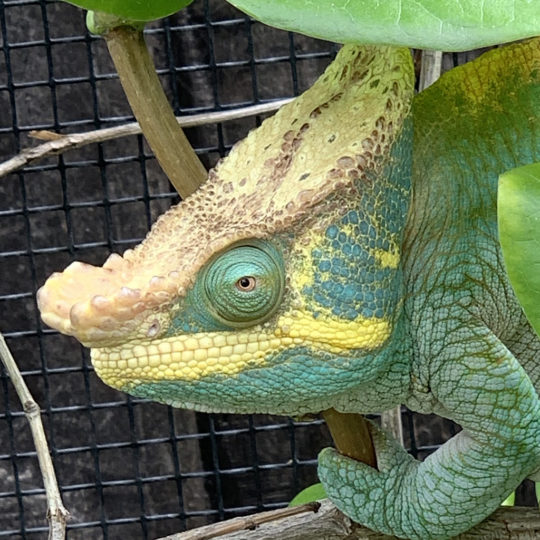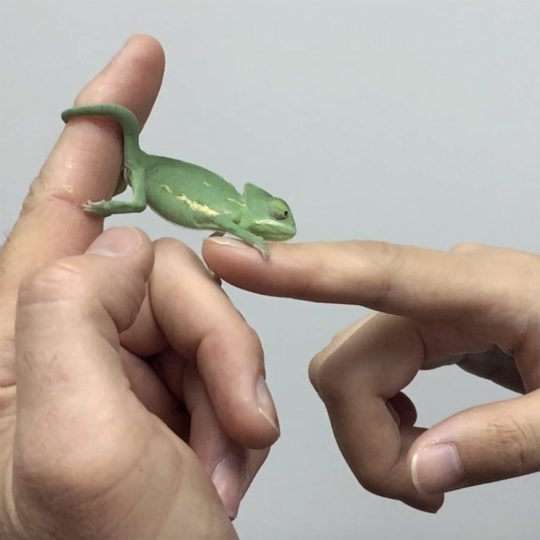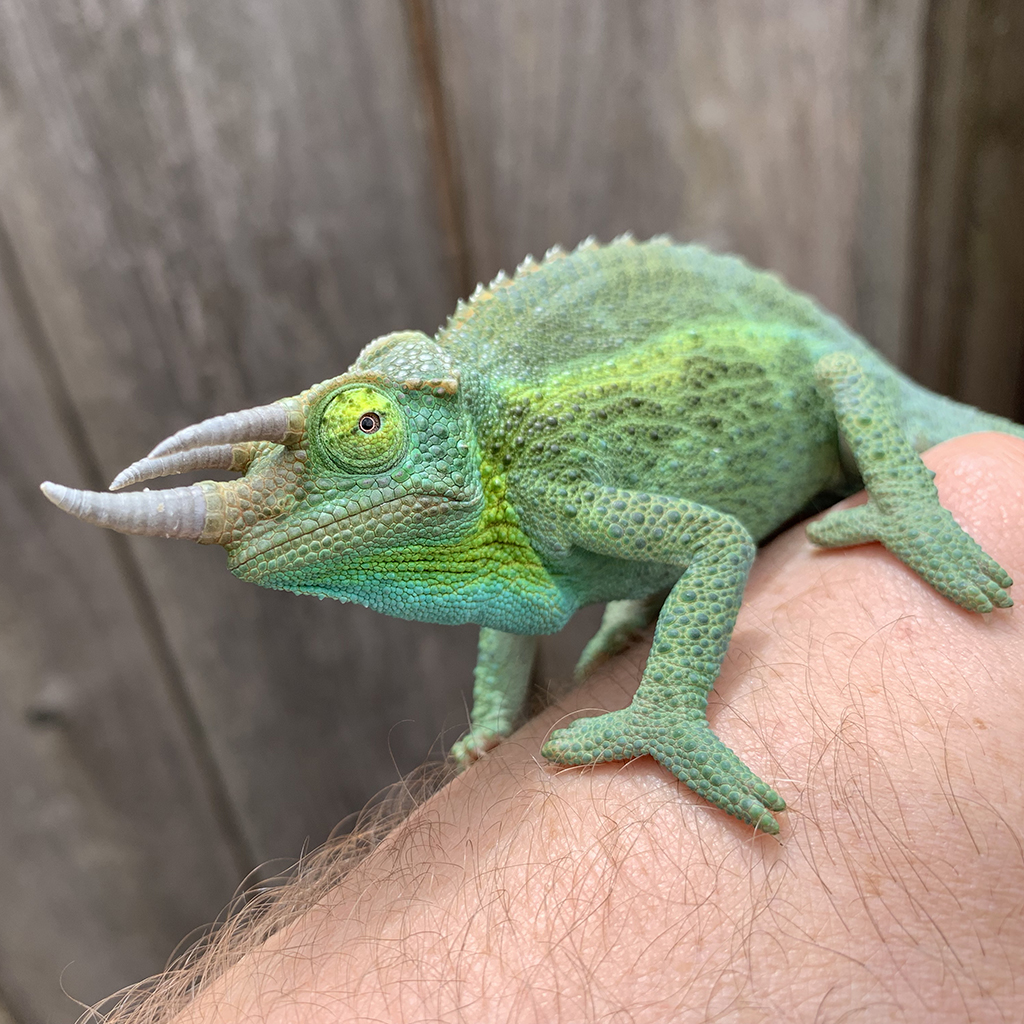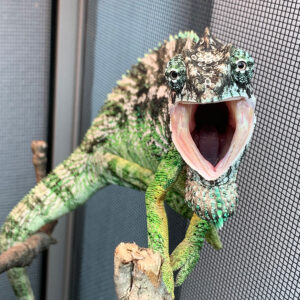Summary: Handling Chameleons
- Chameleons are a pet to be observed, but not handled
- Chameleons are intelligent and will recognize keepers
- Highly intelligent species include Veileds, Panthers, Meller’s, and Parson’s Chameleons
- Each individual will deal with handling differently
How Chameleons View Humans
There is nothing in a chameleon’s evolutionary development that has prepared it for being a pet. They have been successful with the philosophy that anything bigger than them will eat them. And we happen to fit that description. So, to have a roommate situation with them is asking them to go against their DNA.
But, there is a decision point in a chameleon’s brain. Since we do not fit cleanly in their evolutionary preconceived buckets, each chameleon needs to make a decision as to whether we hairless apes are a threat or if we are just a moving tree that means food. Most chameleons assume that we, as a bigger animal, fall into the predator category and are stressed when they are in proximity to us. Eventually they get past the fear of being eaten, but they can never get totally comfortable with being with us. At the far other end of the spectrum is the chameleon that decides to put us in the moving food-tree bucket. This chameleon may get eaten in the wild, but in captivity they actually do better! This is the chameleon that is excited to run to you and crawl on your hand. They get great publicity, but you have to be careful to realize that 1) very few chameleons are like this and 2) if you didn’t get Mr. Friendly DNA, there is only so much you can expect to do as far as taming. As individuals, each chameleon will have their own responses to a long term relationship with you. As it is your choice to bring your chameleon under your care, you will have to learn his language and learn his boundaries. You need to go at his pace and accept that your relationship vision, whatever it is, may take a long time or may never happen. The best approach is to not fixate on your end goal, but to just enjoy the relationship, as it is, each day.
Chameleons Are Intelligent

One thing going for you is that chameleons are quite intelligent as far as recognizing humans and the passage of time. Your chameleon will get to know you by sight and you will notice behavior changing when another person walks into the room. Though, they can be fooled by different visual structures such as wearing a cap, sunglasses, a certain color shirt, etc…Each chameleon will have their own visual item that confuses them. But do not be surprised if your chameleon will eat from your hand and be comfortable with you in his cage space, but suddenly go into fight or flight mode when another human comes in the room.
You will also find that they have some concept of time. Back when I kept a regimented schedule and fed in the same place at the same time each day, I noticed my panther chameleons knew exactly when to come out of their bushes and where to sit each day to get their food.
So when you are trying to hold or tame your chameleon just be aware that you are dealing with an intelligent being and treat them with respect. They can learn trust and their innate fear from their survival instincts can be lessened with time.
Picking up a chameleon

The key to picking up your chameleon is to let your chameleon walk onto your hand instead of you grabbing him out of the branches. There are five grabbing parts (four feet and one incredible tail) that will be constantly looking to be anchored to something. This makes forcefully snatching a chameleon out of the branches a dangerous move. Even when you think you have all five off the branch each one of them (especially the tail) are lashing about looking for something to grab on to as you pull them out of the cage. This is when it becomes very easy to break bones in your chameleon. Place your hand, or branch that you are holding, in front of your chameleon and use your other hand to herd him onto your waiting hand. In this manner, you are working with your chameleon and each time you do this your chameleon learns that it is nothing to be feared.
There always will be that time when you have to pick them up and they refuse to go. In this case you need to be absolutely sure that all feet and tails are free before extracting them.
Handling

Chameleons don’t do much when handled except stay frozen and hope they aren’t noticed or they try to get to the highest point. This is often your head. Very comfortable chameleons may eat while being held, but few chameleons reach the point where they are that comfortable.
One of the biggest mistakes chameleon keepers make is to try and turn their chameleon into a playmate. Handling is only for when cage maintenance or medical procedures need to be done. You will probably have heard that handling causes stress and stress kills chameleons. This statement is based in truth. Long term stress will cause a chameleon to go downhill until they die. And handling is a stress. But handling is a stress spike. It is there and then gone. This kind of stress spike gives no long term damage. It is playing with chameleons on a regular basis that starts to cause problems. “Playing” with your chameleon is when you walk around with him on your head or do the treadmill where you have him walk from one hand to the other in an endless loop.
The argument is often made “I know my chameleon and my chameleon enjoys being out”. It is true. Each chameleon is an individual. But acknowledge the trap we humans fall into. We want our chameleon to show us some semblance of human love, affection, or companionship. Our minds will do what it takes to see the world we want. I have seen countless chameleons that are trying to escape an inadequate cage environment being played with because their attempts to escape their cage are taken as a wish to play. Chameleons are still wild animals. Even captive bred ones retain most of their natural instincts. I’ll not deny there are exceptionally friendly chameleons out there. And maybe you will get lucky! But please do not try to create a situation in your mind that does not really exist. A chameleon is not a pet to get if handling is a top priority.
A Positive Handling Session
The best handling session with a chameleon is one where they crawl out of their cage on their own and you provide them with climbing options. Maybe offer them a special treat while they are out. You want this interaction to be as much of their choice as possible. If they seem interested in coming out then they should be open to crawling out on your hand or a stick.
Most of the time, though, you will encounter a chameleon that is not interested in coming out. If it is a Jackson’s Chameleon you are likely to still be able to get them to climb on a stick you provide by herding them onto it with a “herding” hand from behind. If it is a veiled chameleon you are likely to end up with a spirited chase around the cage with a fiery demon ready to bite if he can shake you by slipping around the pothos. It is at this time that you need to decide whether you are doing more damage to your relationship than good by pursuing.
This video below explains the basics of handling your chameleon properly.
Navigation
This seminar is part of the introductory course Chameleon Basics which, in turn, is a module within the even larger Term 1: Getting Started With Chameleons.
This seminar is the last in the Chameleon Basics course. The next course in Term 1 is Choosing Your Chameleon!





